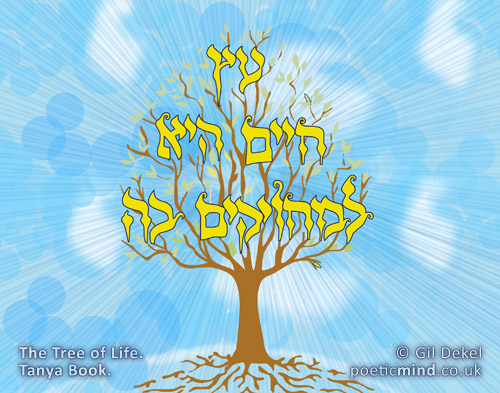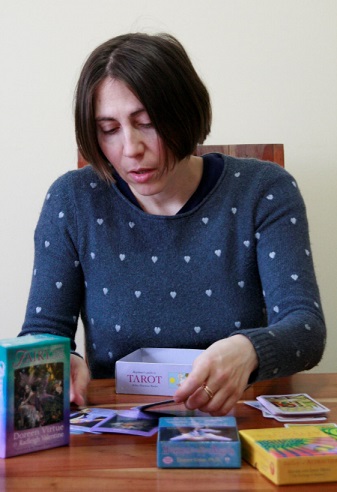with Gil Dekel.
אך הענין כי הנה מצינו בגמרא ה’ חלוקות. צדיק וטוב לו צדיק ורע לו רשע וטוב לו רשע ורע לו ובינוני.
“The matter is as follows. We find in the Gemara five categories [of human beings]. Tzadik ve Tov Lo, Tzadik ve Ra Lo, Rasha ve Tov Lo, Rasha ve Ra Lo, and Beinoni”.
ופירשו בגמרא צדיק וטוב לו צדיק גמור צדיק ורע לו צדיק שאינו גמור
The Gemara goes on to explain some of the categories. The first category is ‘Tzadik ve Tov Lo’ (‘Tov’ is the Hebrew word for ‘good’); what do we mean by Tzadik ve Tov Lo? One of the explanations (which is not the one the Alter Rebbe chooses) is that a person is a Tzadik and he has the good life i.e. life is good to him. He’s a righteous person and he prospers.
But the Alter Rebbe gives another explanation, which does not come to negate those other definitions, but rather to explain the deeper meaning of the words. ‘Tov Lo’ means that he has good in him, he is a Tzadik Gamur, absolute righteous; a complete Tzadik, who has only good within him, a ‘wholesome’ of goodness is embedded in his personality.
And there is another type of Tzadik, this is the ‘Tzadik ve Ra Lo’ (‘Ra’ is the Hebrew word for ‘bad’). So, we could suggest that this is a Tzadik who is going through suffering; a Tzadik who is having difficulties in his life.
Again, the Alter Rebbe says no; the explanation we’re going to give here for ‘Tzadik ve Ra Lo’ is that he is a ‘Tzadik she’Eino Gamur’, a Tzadik which is incomplete. This Tzadik has some bad inclination within him, naturally, as people do. So, there is a certain level deep within him which is not quite pure and right. The words ‘Ra Lo’ does not refer to hardship in life, according the Rebbe, rather indicate that this kind of Tzadik has bad inclination in him, which is natural. He is incomplete.
We ask: how could it be that he has some badness in him and he is still referred to as a Tzadik? How can there be a Tzadik who has bad inclination? That’s a question we will now explain.
וברעיא מהימנא פ’ משפטים פי’ צדיק ורע לו שהרע שבו כפוף לטוב וכו’
In the famous book of ‘Raya Mehemna’, Parashat Mishpatim, it is explained that ‘Tzadik ve Ra Lo’ is someone whom the bad in him has become subjugated to the good, or ‘Kafouf’, which literally means ‘bent over’.
The ‘Raya Mehemna’ explains that this is not a contradiction; because in this Tzadik, the ‘Ra’, the bad, cannot raise its head. Like the volcanoes before they go off, it’s in a state of dormancy; it has no voice or effect, it is inactive. Therefore, he retains the title of Tzadik – as we shall see in more detail as we go on.
So, we have here ‘Tzadik ve Tov Lo’ who is ‘Tzadik Gamur’; he naturally has goodness in him. And the other Tzadik is ‘Tzadik ve Ra Lo’ who is ‘Tzadik she’Eino Gamur’ as he has bad inclinations, yet that badness in him is subjugated, inactive.
ובגמרא ספ”ט דברכות צדיקים יצ”ט שופטן כו’ רשעים יצה”ר שופטן בינונים זה וזה שופטן וכו’
In the Gemara at the end of chapter 9 of the tract of Brachot (the blessings), it says: everybody has in them the Yetzer Tov (good inclination) and also the Yetzer ha-Ra (the bad inclination); but in the Tzaddikkim (righteous people), the Yetzer Tov is completely in charge. When it comes to making a judgment as to what to do, the Yetzer Tov has got a monopoly, a single lone voice which leads the way.
On the other hand, in the Rashayim (those people that are corrupt), the Yetzer ha-Ra has got the lone voice. And the Beinonim are those who have a sort of dynamic tension between the two different levels – the good and the bad. There are two voices within the Beinoni that continually giving opposite opinions. They are both like ’Shoftim’, like judges in a court of law. Each one gives what he believes should be the fact. One is the voice of the Yetzer ha-Ra, and the other is the Yetzer Tov.
Therefore, we see that according to the Gemara, the Beinoni is definitely someone who has a conflict going on within. It seems to be that the Tzaddikkim and the Rashayim do not really have any conflict at all. For the Tzaddikkim it is all good; for the Rashayim, it is all bad. But the Beinonim always have two conflicting voices.
אמר רבה כגון אנא בינוני א”ל אביי לא שביק מר חיי לכל בריה
The Gemara, in the tract of Brachot, goes on and quotes one of the greatest sages of the Talmud, called Rabbah רבה . While trying to clarify the subject of what is a Beinoni to his Talmidim (pupils) Rabbah used himself as an example and said “For example, I am a Beinoni.” One of his greatest student and friend, Abbaye אביי , was astonished. He couldn’t imagine how Rabbah could say that he was a Beinoni, because Abbaye and all people were convinced that he was a Tzadik. He replied to his teacher: “You, master leave no life for the whole of creation.”
What Abbaye meant to say is that if Rabbah was a Beinoni, and many students felt that they were on a lesser level than him, then in their eyes, he was implying that everybody else must be a Rasha, i.e. a level below the Beinoni.
The Tzaddikkim are channels of light into the world. If a Tzadik implies that they are not a Tzadik when they clearly are, then everybody else must be even lower than they are. If Tzaddikkim claim to be Beinonim, then there are no Tzaddikkim in the world at all. If Rabbah claims not to be a Tzadik but a Beinoni, then everyone else is lower than him.
That is what was upsetting Abbaye. We need to understand what did Rabbah meant by attributing himself that he was a Beinoni. The presumption is that he really was a Tzadik. Clearly, in his own mind, he didn’t consider himself to be a Tzadik. He wasn’t being falsely modest – a teacher of the stature of Rabbah wasn’t going to make false modest statements – he genuinely felt that he was a Beinoni. Yet, he was a Tzadik.
How is it possible for someone who really was on a level of a Tzadik to mistake himself to be a Beinoni? When we go on learning the Tanya we will see that the level of a Beinoni is very high, so much so that Tzaddikkim can come to think they are actually Beinonim.
Once we understand this, it will help us analyse the definition of what a Beinoni is.
20 Jan 2012.
© Gil Dekel. My thanks to my teachers.
Likkutei Amarim – Tanya, Bi-Lingual Edition, Revised, ISBN 0-8266-0400-5, ‘Kehot’ Publication Society, NY. 1993 [© 1984].
This lesson if for page 2 in the book.



 - Reading with Natalie, book here...
- Reading with Natalie, book here...